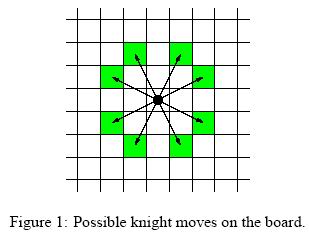Description
Background
Mr Somurolov, fabulous chess-gamer indeed, asserts that no one else but him can move knights from one position to another so fast. Can you beat him?
The Problem
Your task is to write a program to calculate the minimum number of moves needed for a knight to reach one point from another, so that you have the chance to be faster than Somurolov.
For people not familiar with chess, the possible knight moves are shown in Figure 1.

Mr Somurolov, fabulous chess-gamer indeed, asserts that no one else but him can move knights from one position to another so fast. Can you beat him?
The Problem
Your task is to write a program to calculate the minimum number of moves needed for a knight to reach one point from another, so that you have the chance to be faster than Somurolov.
For people not familiar with chess, the possible knight moves are shown in Figure 1.

Input
The input begins with the number n of scenarios on a single line by itself.
Next follow n scenarios. Each scenario consists of three lines containing integer numbers. The first line specifies the length l of a side of the chess board (4 <= l <= 300). The entire board has size l * l. The second and third line contain pair of integers
{0, ..., l-1}*{0, ..., l-1} specifying the starting and ending position of the knight on the board. The integers are separated by a single blank. You can assume that the positions are valid positions on the chess board of that scenario.
Next follow n scenarios. Each scenario consists of three lines containing integer numbers. The first line specifies the length l of a side of the chess board (4 <= l <= 300). The entire board has size l * l. The second and third line contain pair of integers
{0, ..., l-1}*{0, ..., l-1} specifying the starting and ending position of the knight on the board. The integers are separated by a single blank. You can assume that the positions are valid positions on the chess board of that scenario.
Output
For each scenario of the input you have to calculate the minimal amount of knight moves which are necessary to move from the starting point to the ending point. If starting point and ending point are equal,distance is zero. The distance must be written on a
single line.
single line.
Sample Input
3 8 0 0 7 0 100 0 0 30 50 10 1 1 1 1
Sample Output
5 28 0
题目大意 就不多说啦 ,很简单 。
具体讲解 请看代码 :
#include<iostream>
#include<cstdio>
#include<cmath>
#include<algorithm>
#include<cstring>
#include<string>
#include<queue>
using namespace std;
const int MAXN = 600;
struct point
{
int x;
int y;
int dis;
};
int vis[MAXN][MAXN]; // 定义标记数组
int X[8]={-2,-2,-1,-1,2,2,1,1}; // 8个前进方向
int Y[8]={-1,1,-2,2,-1,1,-2,2};
int bfs();
int cango(int i,int j); // 判断能否前进的函数
int n; // 此程序中的n 即为 题干中的 l
queue<point>myqueue; // 此处 把队列 定义成全局的
point start,end; // 定义起点和终点
int main()
{
int t;
scanf("%d",&t);
while (t--)
{
scanf("%d",&n);
memset(vis,0,sizeof(vis));
scanf("%d%d",&start.x,&start.y);
scanf("%d%d",&end.x,&end.y);
if(start.x == end.x && start.y == end.y)
{
printf("0\n");
continue;
}
while(!myqueue.empty()) // 注意 : 此处为清空队列,非常重要 ,因为队列是全局的 所以测试每个样例
// 都要先把队列清空 ~~(不然会 WA !!)
myqueue.pop();
printf("%d\n",bfs());
}
return 0;
}
int bfs()
{
start.dis = 0; // 注意: start.dis 要提前赋值为 0
myqueue.push(start);
vis[start.x][start.y] = 1; // 标记此点已被访问
point temp,next;
while (!myqueue.empty())
{
temp = myqueue.front();
myqueue.pop();
int k;
for(k=0;k<8;k++)
{
next.x = temp.x+X[k];
next.y = temp.y+Y[k];
if(cango(next.x,next.y))
{
next.dis = temp.dis + 1;
if(next.x == end.x && next.y == end.y)
return next.dis;
myqueue.push(next);
vis[next.x][next.y] = 1;
}
}
}
}
int cango(int i,int j)
{
if(i>=0&&i<n&&j>=0&&j<n&&vis[i][j]==0)
return 1;
return 0;
}